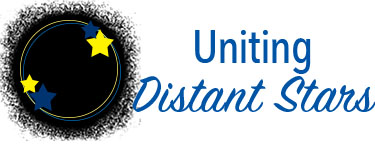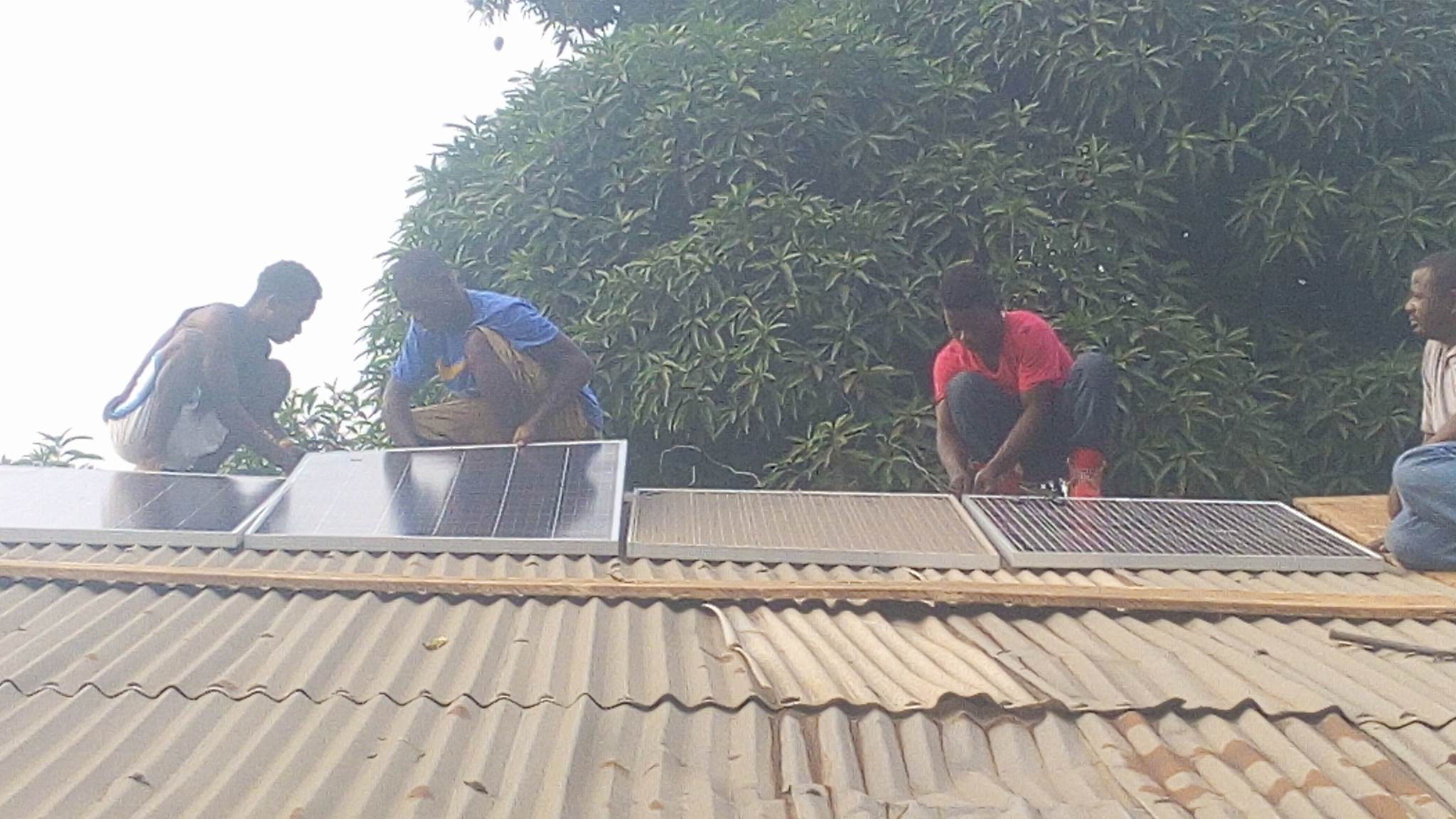
by heather-cstars | Jan 27, 2019 | Africa, Electrician Course, Liberia, NGO, Real Experience, Skills training, Solar Panels, Solar Power, Sustainable Training, Thank You, Trade School, Uniting Distant Stars, vocational training, youth development, Youth Empowerment
As a small and humble organization, our gratitude reaches beyond the stars everytime you make a dream come true. Our quest for solar started a year ago when our small group visited a farm in Carver, Minnesota that was fully operated by this renewable energy. This experience gave us the hope and inspiration to make this possible. In June, we discussed this opportunity at our strategic plan meeting to determine the feasibility. After agreeing to move forward with this project, the fundraising plans began. In October, a fundraiser in New York City raised over $5,200 for this initiative. And as of January 26, 2019, solar power electrifies our center.
The first phase of our solar initiative provides 24/7 lights, runs ceiling fans for cooling in our classrooms, and supports our business office during the day. A total cost of $6,000 (includes general funds) purchased all the materials for phase 1. As a learning opportunity, the vendor Taleance T Tokpah (the owner of T & T Solar Tech) worked with our electrician students to install the solar.
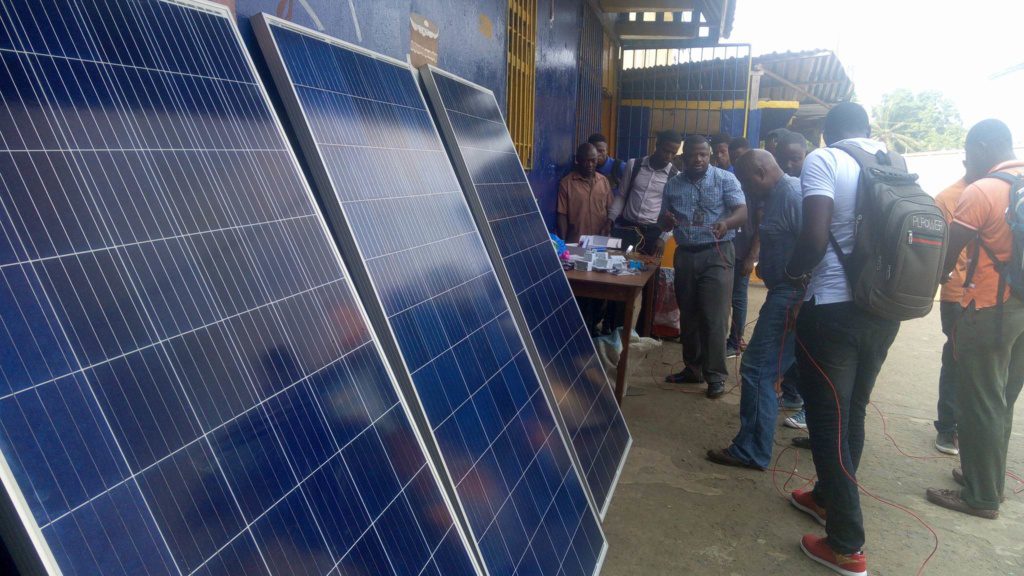
Taleance T Tokpah standing in the center by the table instructs our students on how to test the panels.
Before we can implement phase 2, our diesel generator will be used for our computer training course three times a week. In the near future, we will discuss the next steps to cover all our center’s power needs on solar. In the meantime, please enjoy the photos of our students learning something new.
Panel Installation
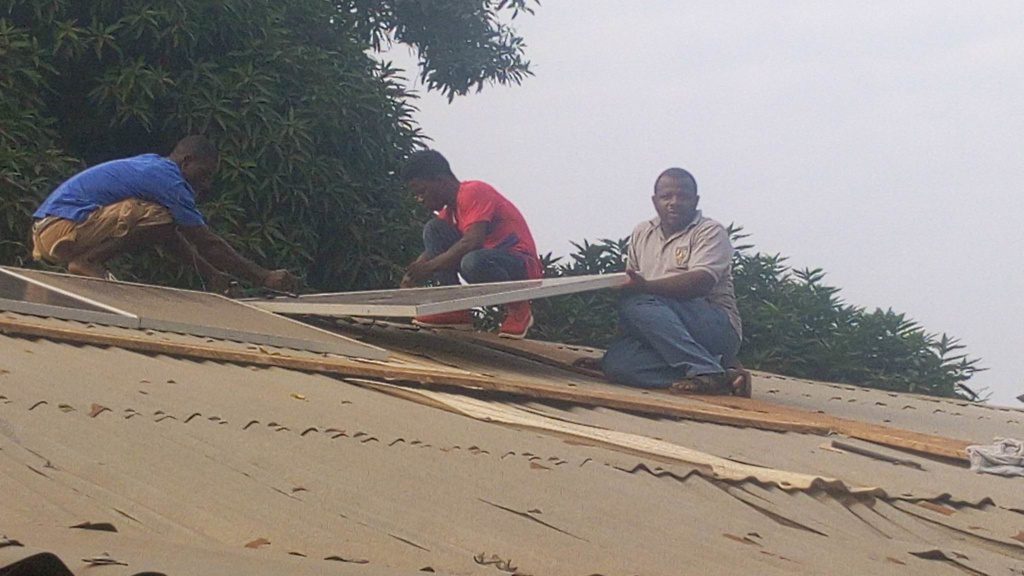
You empowered our electrician students (blue and red shirts) to help install our solar panels with our vendor and technician, Taleance T Tokpah.

Your electrician students working together to install solar panels under the guidance of Taleance T Tokpah.
Wire Connection
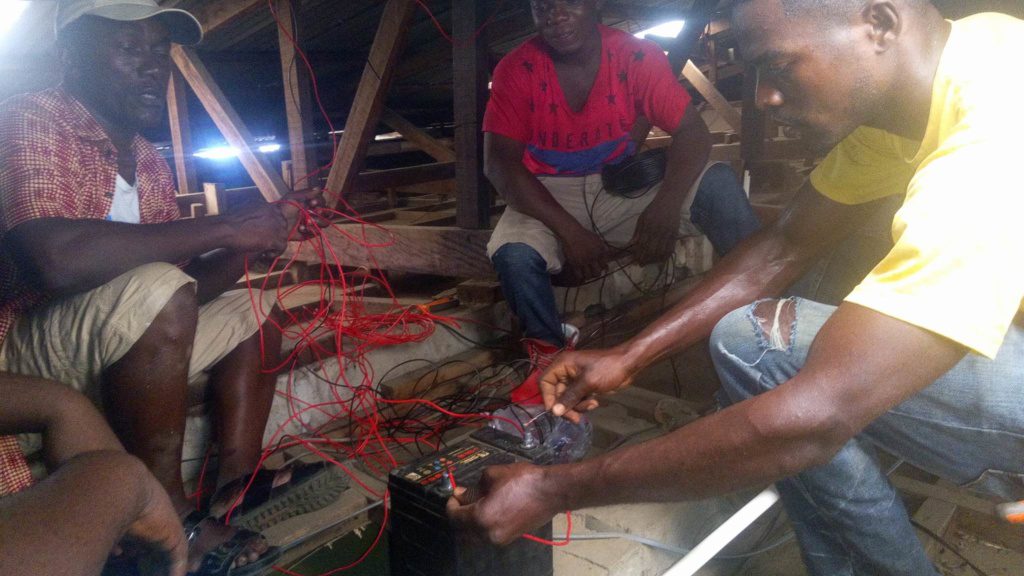
Your students and Kelvin Fomba (UDS Co-Founder & Director) testing the connections between the roof and ceiling.
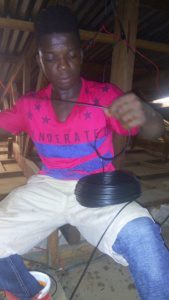
Your student preparing the wire to connect the panels to the control box.
UDS Lights Powered By Solar

UDS Training Center now powered by solar.
Thank you so much to our generous supporters in New York City! You gave our students reliable and stable electricity at our center. What remarkable gift! Also, our sincere thanks to Taleance T Tokpah for sharing his knowledge and expertise with our students!
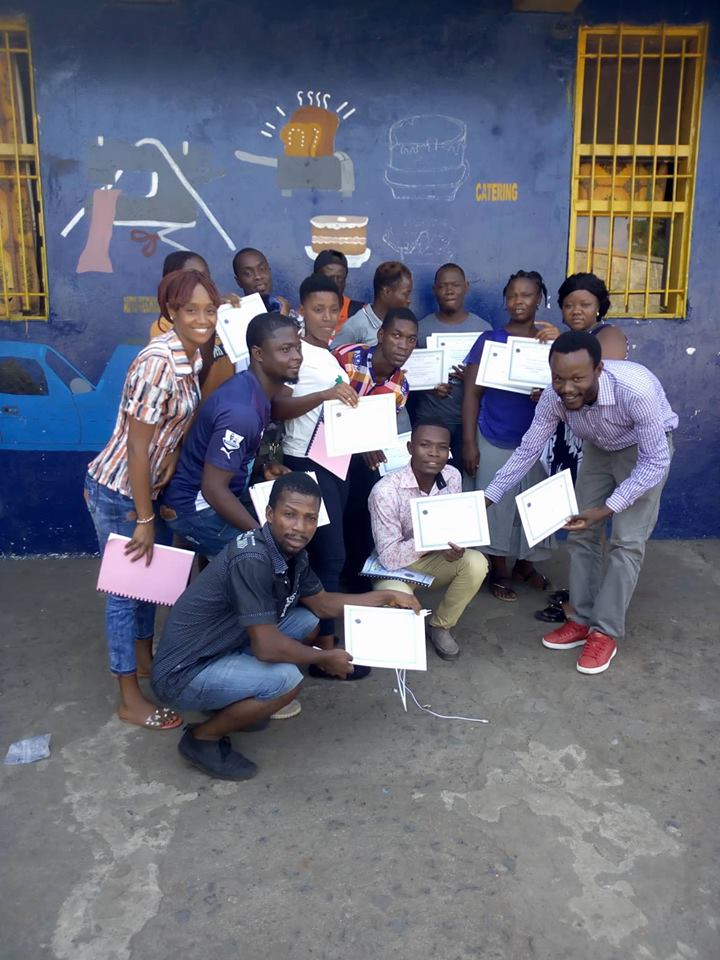
by heather-cstars | Jan 20, 2019 | Africa, African Dream Academy, Cake, Catering Course, Hotel Management Course, Liberia, NGO, Permaculture Training, Sierra Leone, Sierra Leone Foundation for New Democracy, Skills training, Trade School, Uniting Distant Stars, vocational training, youth development, Youth Leadership
Our first permaculture training successfully ended on January 16, 2019. Last week, we shared photos and information about the first five days of training. This week’s article focuses on the remaining four days of the Permaculture Design Certification Training.
Day 6 – Polyculture & Introduction to Group Projects
Bruce Blair (Board Member & Trainer for SLFND) demonstrated the benefits of polyculture with a model. He explained that polyculture is where unrelated plants grow together. He also showed videos of one particular type of polyculture: The Three Sisters. Typically, the Three Sisters include corn (maize), climbing beans, and squash. This practice originated from Native Americans.

Bruce Blair (SLFND) sharing short documentaries on polyculture and explaining the process to our students.
Bruce discussed group assignments where students create their own design projects. Additionally, he gave our students the option to select a site or social design. What is the difference? Site design focuses on a single garden or farm project, whereas social design includes the whole system design (i.e. economic, environment, health, etc.).

Bruce explaining the group design projects using his model as the example.
After the assignment discussion, the students reviewed the notes on the board in preparation for their group project. Group presentations started on Monday.
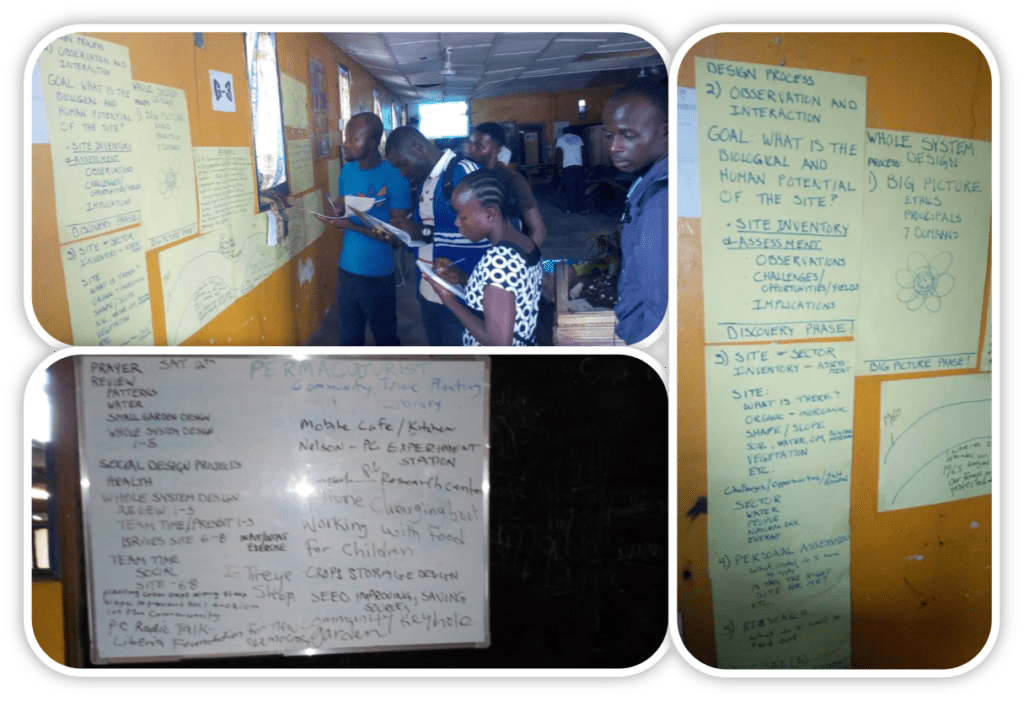
UDS students taking notes of their group project assignment.
Days 7 & 8 – Student Presentations of Group Projects & Banana Cycle
On Monday, the groups took their turn to demonstrate what they learned in this class. Each student of the group needed to share something about their project in order for Bruce to assess their knowledge of the permaculture process. As you see in the photos below, our students used different types of 2-D or 3-D models to explain their group projects.
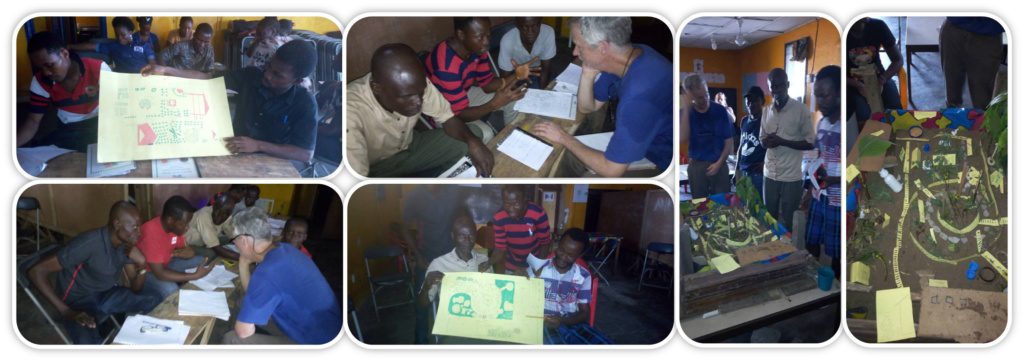
Photos (left to right) show different group presenting their group projects. Some drew their designs on paper while others used a 3-d model.
On Tuesday, Bruce took the group over to the field site to discuss the banana cycle. A banana tree can reproduce itself. Instead of a seed, it grows from the bulb (rhizome).

Bruce explaining how the banana tree reproduces itself.
Day 9 – Final Presentations & Certification Ceremony
The group presentations continued into day 9. Clearly, our students put a great deal of effort into their group project designs. As result, they met the course requirements to be certified in Permaculture Design.

UDS Co-Founder & Director was part of this group project on social design.
Halfway through the day, they paused the group presentations. Joy Alizadeh would soon be leaving, and they wanted to recognize both her and Bruce. So, Kelvin Fomba (UDS Co-Founder & Director) joined Bruce and Joy up front to express the gratitude of all the students. Then he presented them a surprise Thank You Cake made by our catering students.
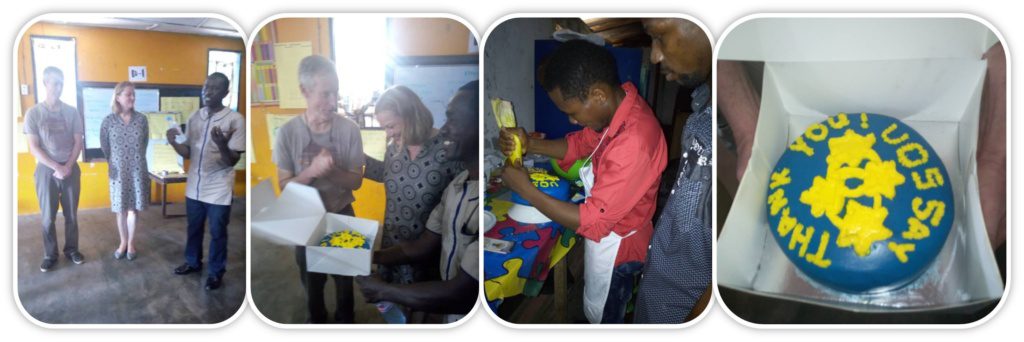
Photos (left to right): 1) Kelvin giving UDS appreciation to Bruce & Joy, 2) Kelvin presenting the Thank You cake to Bruce & Joy, 3) Catering Students icing the cake, & 4) Bruce holding the cake.
Soon after Joy left, the group presentations resumed. Once the last one ended, the certification ceremony began. Our long-time friend, Rev. Samuel Enders presented each student with their certificate. He also gave a motivational speech about taking this knowledge and putting it to use immediately. In fact, this course taught our students they can start with the resources of the earth and their own two hands.
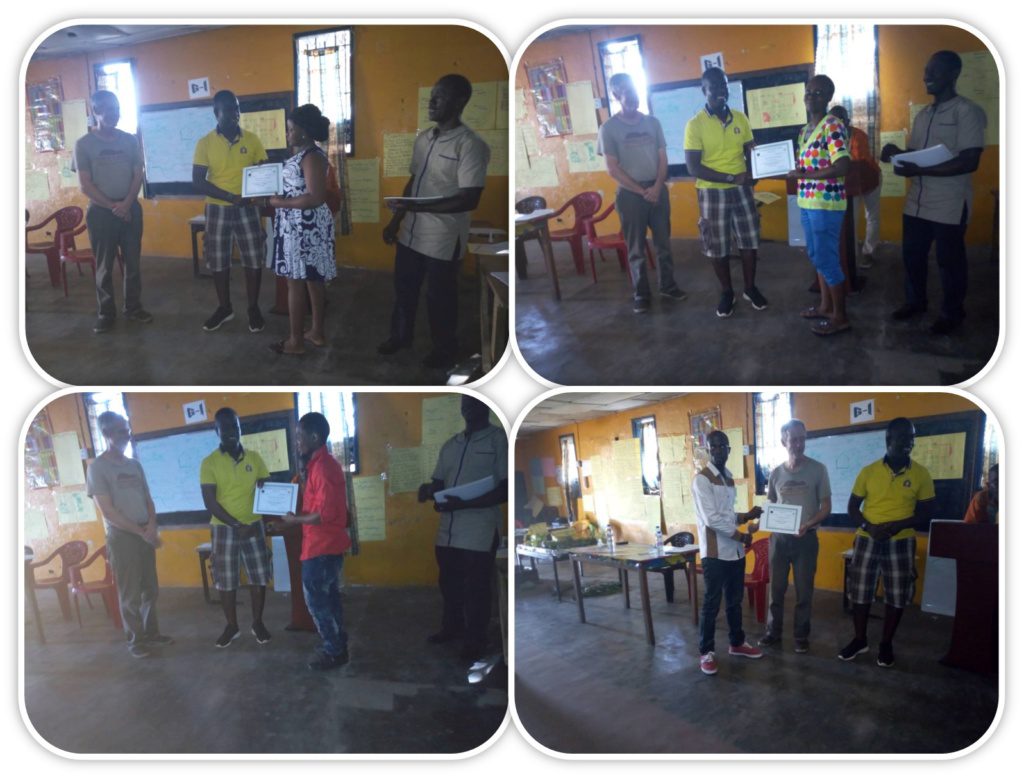
Rev. Samual Enders of African Dream Academy (yellow polo) presented the students with their certificates. Bruce is on the left and Kelvin on the right.
Celebration!
Next, our students took photos to share their excitement with you. We had 41 out of 45 students successfully complete this course. Unfortunately, the other four had to drop due to scheduling conflicts.
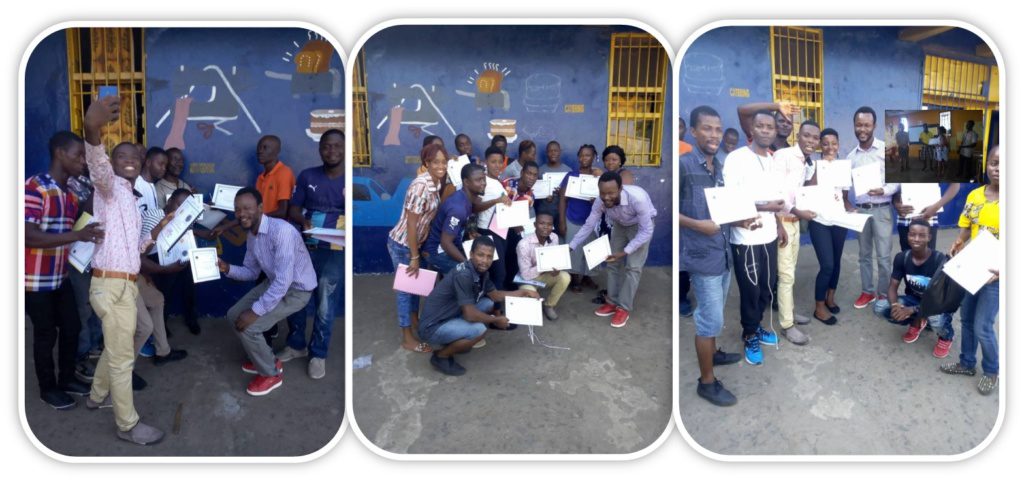
UDS students celebrating and proudly displaying their certificates.
Finally, I want to Thank all our dedicated students and team for their active participation in this course and taking good care of our guests! Additionally, I want to extend our sincerest Thanks to our four sponsors (Ali, John, Edward, and Joel) and SLFND Team (Hindolo, Bruce, Joy, and Brenda) for their support!
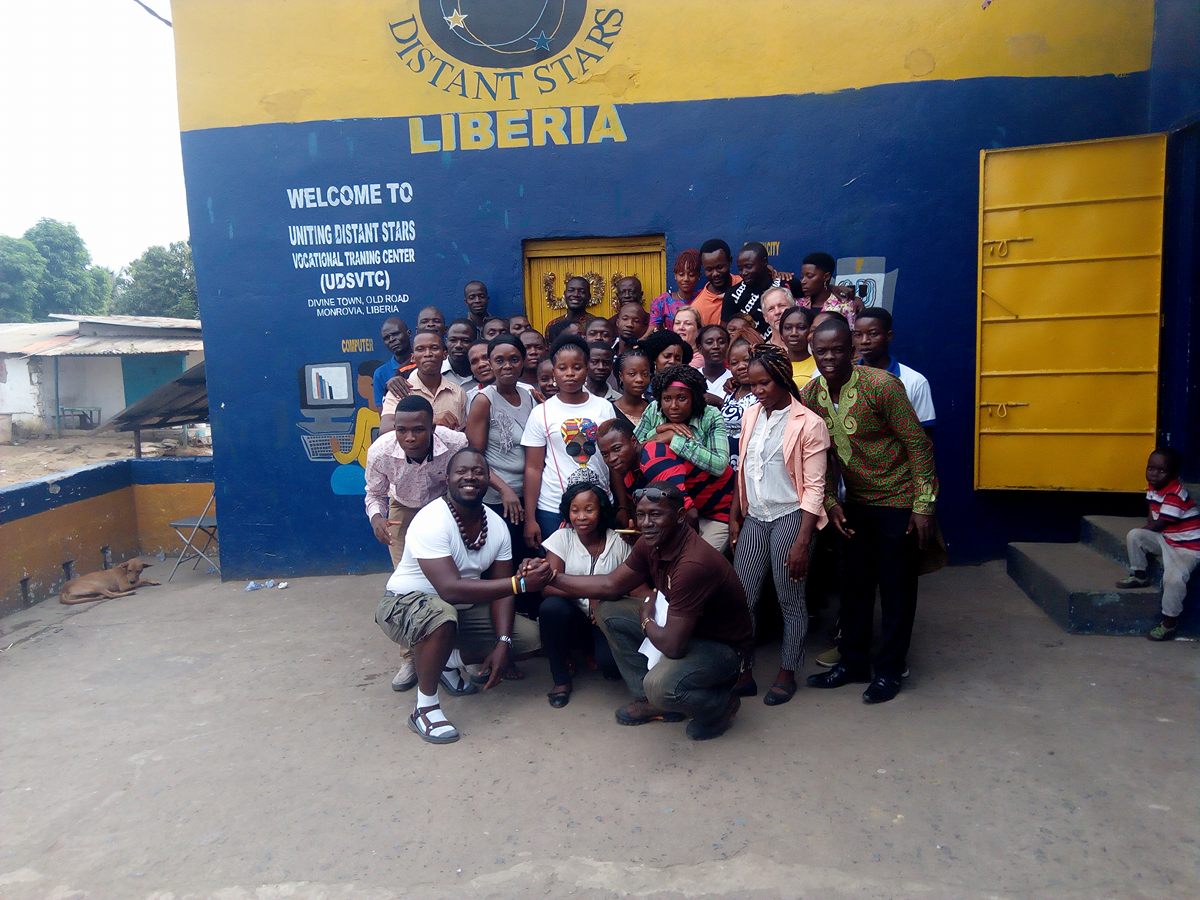
by heather-cstars | Jan 14, 2019 | Africa, Liberia, NGO, Permaculture Training, Sierra Leone, Sierra Leone Foundation for New Democracy, Skills training, Trade School, Uniting Distant Stars, vocational training, Youth Leadership
Happy New Year! 2019 began on a high note with the Permaculture Design Certification (PDC) training starting on January 7. This training equips people with the knowledge and skills needed to implement a project for food security. First, the PDC training teaches our students about available resources–organic material and soil–to use for sustainable living. Second, PDC offers mostly applied knowledge similar to our vocational training courses. Lastly, this training gives our students the opportunity to work together and learn better approaches to gardening and farming.
Without a doubt, this course piqued the interest of all our students. Initially, the course limit was 35. However, this number increased to 45, including two agricultural students from the University of Liberia.
To illustrate the value of this course, the rest of this article will summarize the first five days with photos and explanation of each day’s assignments.
Day 1 – Introductions & Over of Permaculture Concepts
Our guests from Sierra Leone Foundation of New Democracy (SLFND) arrived Sunday night. After a night’s sleep in the hotel next door, they started the training on Monday. 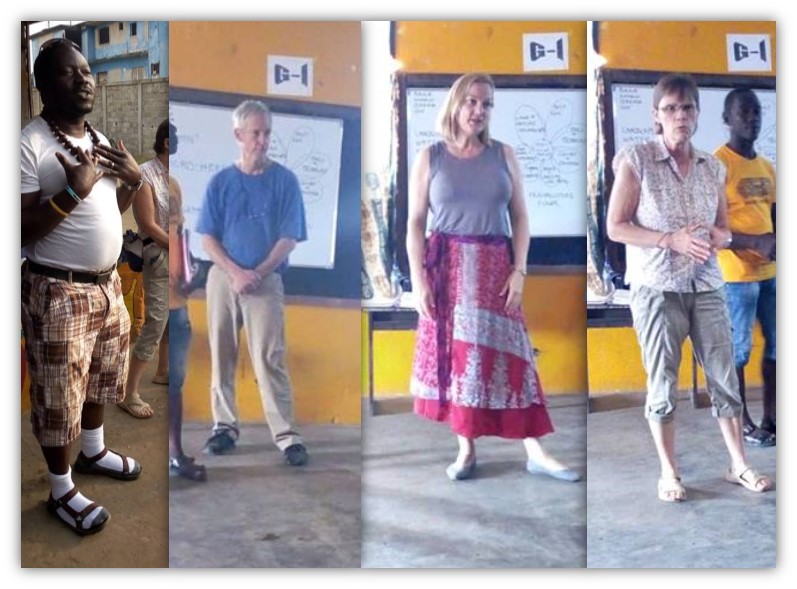 SLFND Team (left to right): Hindolo Pokawa (Founder & Executive Director), Bruce Blair (Board Member & PDC Trainer), Joy Alizadeh (Board Member & Development Director), & Brenda Blair (Early Childhood Development).
SLFND Team (left to right): Hindolo Pokawa (Founder & Executive Director), Bruce Blair (Board Member & PDC Trainer), Joy Alizadeh (Board Member & Development Director), & Brenda Blair (Early Childhood Development).
Bruce Blair spent the day showing slides of his gardens and chickens at his home in Red Wing, Minnesota. Additionally, he introduced many of the concepts they would be learning and applying during this 9-day course. 
Top Photo: Bruce teaching our youth about permaculture concepts. UDS Co-Founder & Director, Kelvin Fomba, helps explain anything that our youth don’t understand. Bottom Photo: Bruce drew a timeline for our students to write information about Liberia’s agricultural history.
Day 2 – Group Photos & Land/Soil Observations
This was Hindolo and Brenda’s last day in Liberia so everyone gathered for group photos. Furthermore, they took photos with our catering and hotel management students. The catering students prepared and cooked their food daily while the hotel management students cleaned their rooms, made beds, and washed and ironed their clothes. As you can see, the smiles on our guests’ faces show they are being well taken care of.
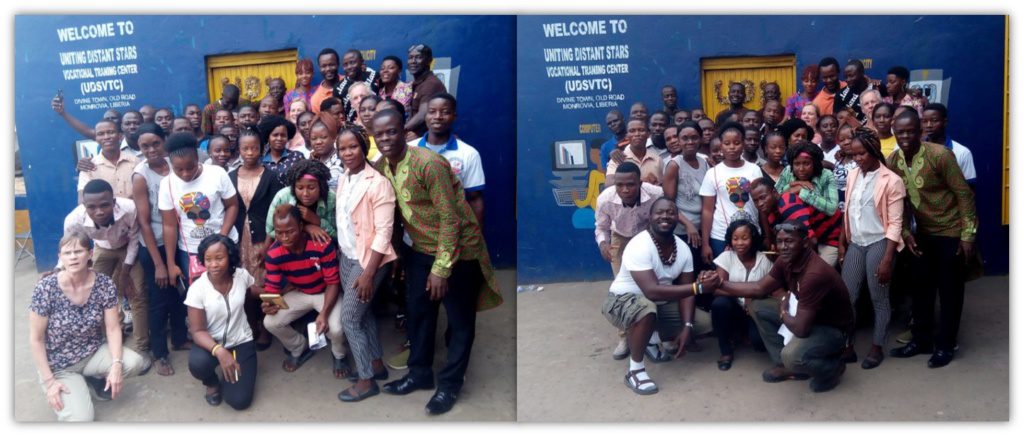
Left photo includes Brenda Blair. Right photo includes Hindolo Pokawa showing brotherly love to Kelvin Fomba.
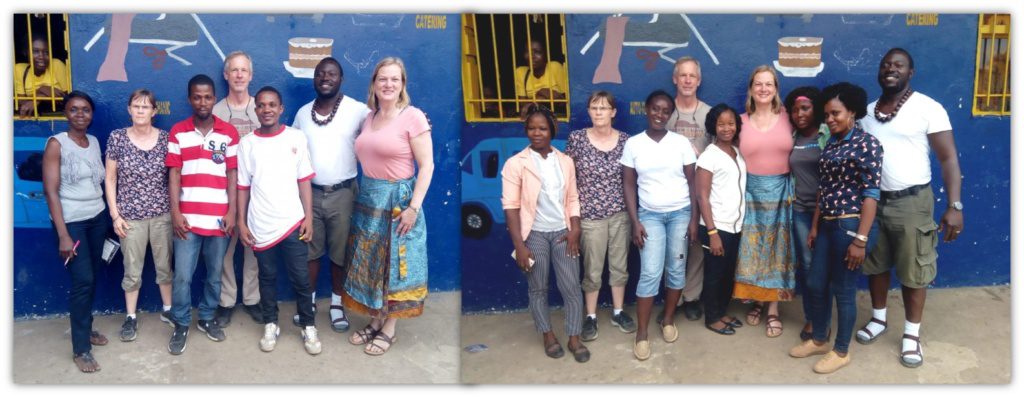
Left photo shows our catering student with their guests. Right photo shows our hotel management students with their guests.
Bruce took the students to the field site and explained how to look for patterns in the soil. Next, he assigned the students to walk the site for 45 minutes without talking and to make any observations. Then, they returned to the classroom and wrote their observations on the board.
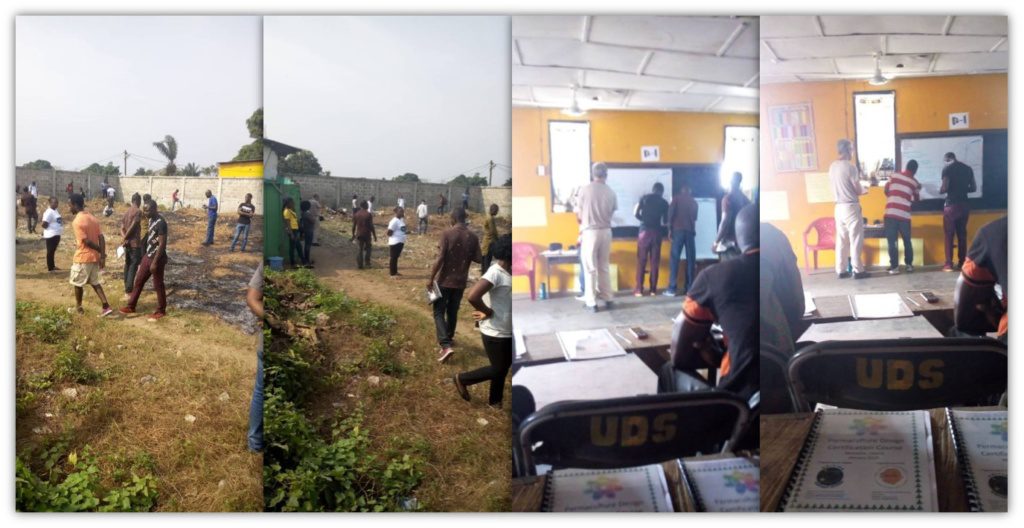
From left to right: students walking the site in silence while observing the area for patterns. Then the students wrote their observations on the board.
Day 3 – Hot Composting
Our students learned about hot composting and built their own heap with branches, leaves, and other organic materials. Hot composting is different from cold composting (the most common one used). Although both processes breakdown the organic matter, hot composting does in days instead of months and kills the weed seeds and pathogens. Plus, it breaks it down into finer material.
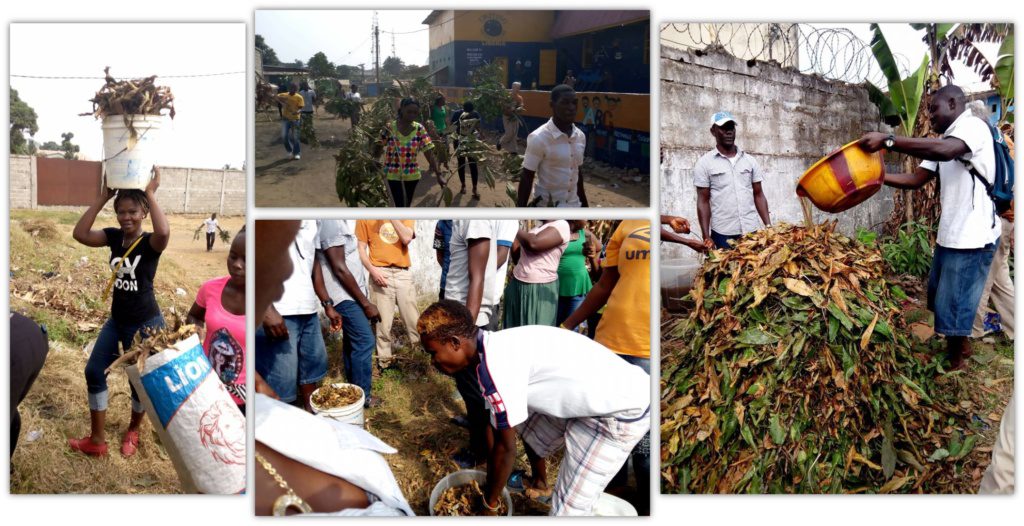
Photos (starting left, clockwise): The students gathered organic material and brought it to the site. The students piled the material into a hot compost heap.
Day 4 – Hugelkulture
Our students continued to apply knowledge at the field site. For instance, they built a Hugelkulture which is a no-till raised bed for growing vegetables. They gathered leaves and branches, placed them on the ground, and then topped with soil and seeds. Because of this process, the bed retains moisture for longer periods and gives a constant supply of nutrients.
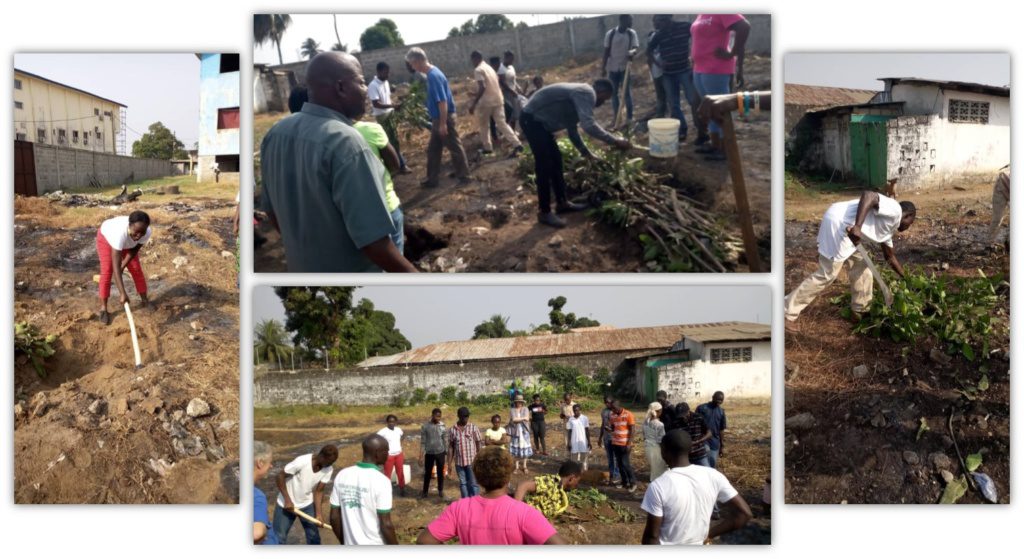
Photos (Starting left, clockwise): The students working together to build a Hugelkultur (raised bed).
Day 5 – Designs & Patterns
On Friday, Bruce explained and demonstrated the design process. He built a prototype of a layout, including where to place trees and gardens in conjunction with roads.
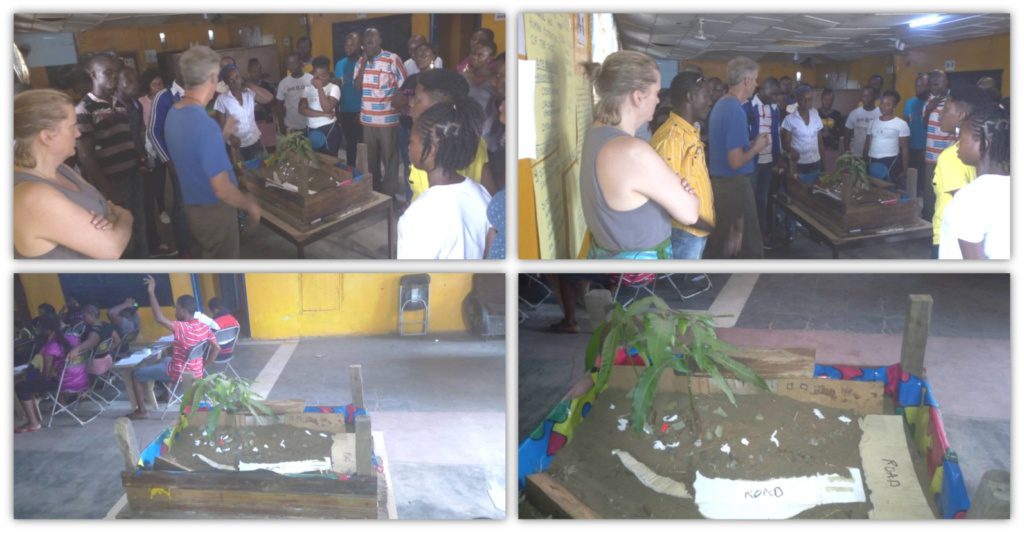
Photos: Bruce explaining and demonstrating how to design a permaculture site. This example is a garden that could be planned for a city or rural area.
As you can see, our students gained some valuable information about using the earth’s resources to better their lives and communities. Next week, we will share the last four days of the training and how our students will apply this in their everyday lives.
Thank you again for our sponsors–Ali, John, Edward, and Joel–for allowing our youth to receive this wonderful opportunity!
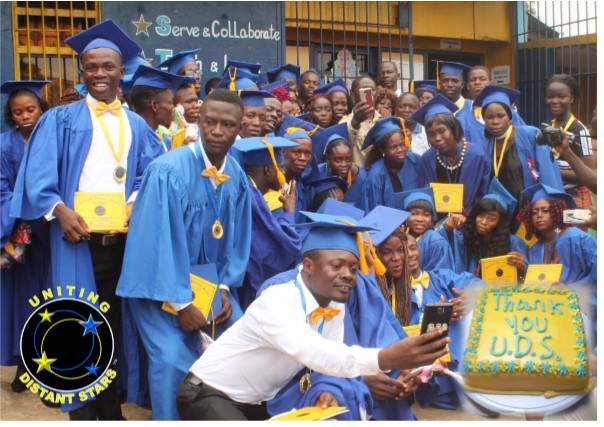
by heather-cstars | Dec 31, 2018 | Africa, education, Liberia, Thank You, Uniting Distant Stars, vocational training, youth development, Youth Empowerment
Your continued passion and service made 2018 our best year yet! As we move into 2019, your generosity will make the following possible:
- a graduation celebration for current eligible students in late March or early April
- new vocational training students for the 2019/2020 one-year term
- small social enterprises for sustainable day-to-day operations
All the Uniting Distant Stars Youth, Instructors, Staff, Board Members, Volunteers, and Co-Founders wish you a delightful and fruitful 2019!
Thank you for being part of the Uniting Distant Stars Community of Supporters!!!
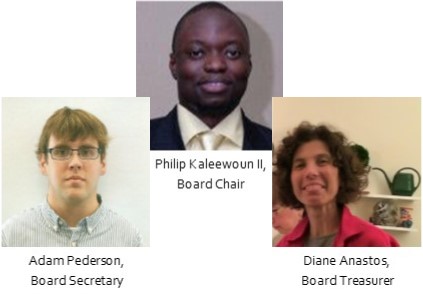
by heather-cstars | Dec 12, 2018 | Africa, Board Members, education, Liberia, Real Experience, Skills training, sustainable development, Trade School, Uniting Distant Stars, youth development, Youth Empowerment
On Saturday, December 8, Uniting Distant Stars held their annual board meeting to elect officers and start planning for 2019. First, we like to announce the re-appointment of our officers (Philip Kaleewoun II, Adam Pederson, and Diane Anastos) for another year. Congrats to our 2019 Board Officers!
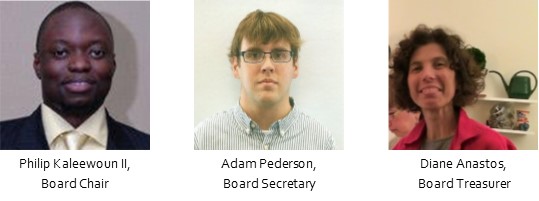
Fundraising Team
Second, we like to share that three of our board members (Rita Apaloo, Adam Pederson, and Beyan Gonowolo) agreed to collaborate on our fundraising efforts for 2019. Specifically, this tremendous trio will be looking at various events, outreach to businesses and organizations, and other creative ways to fundraise. Thus, this supports Liberian Youth seeking to learn a skill and achieve self-reliance.

Strategic Plan
Third, we discussed the implementation of our strategic plan initiated in June 2018. With this intention, we plan to diversify our revenue streams to meet our main objective of financial stability. For example, the establishment of four social enterprises coupled with our courses as follows:
- Tailoring Shop: sew custom uniforms & clothes or repair clothing.
- Hair Salon: offer services for hair, face, and nails.
- Auto Repair Shop: provide regular maintenance service and repairs.
- Contracted Electrician and Plumbing Services: bid for contracts to build homes, schools, etc.
With this intention, a social enterprise or business allows us to reinvest the profits back into the program and beneficiaries. Also, we have envisioned a social business since we started working in Liberia. Because these small businesses provide the revenue stream to run the day-to-day operations and hire our graduates for permanent jobs.Consequently, Liberia’s economy continues to remain in a slump and this limits any job creation opportunities. Our Liberian Team established some small businesses since we opened our center. So as to generate funds to cover some of the needs. Including selling water and renting out our great hall for events or workshops. In order to expand into these other areas, a list of additional equipments and tools will be compiled by our team to determine the next steps. Ultimately, by transforming our facility into a multi-purpose center, we can achieve our strategic goal of financial stability.
We will keep you posted as we move forward with our plans for 2019. Thank you for your generous support in 2018!





